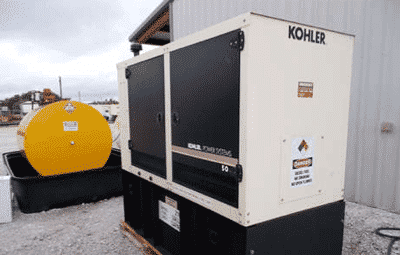EPA Tier 4 Final Regulation Impacts Diesel Generators

Overview
In 2004, the EPA finalized Tier 4 emissions standards for non-road diesel engines. Their take on the approach is to reduce sulfur in non-road diesel fuel to dramatically reduce harmful emissions, which will directly help all States and locales that were designated as 8-hour ozone non-attainment areas (such as California) to improve air quality. These non-attainment areas have strict air-quality standards, which must adhere to the new regulations. This comprehensive national program regulates non-road diesel engines and use of diesel fuel.
Tier 4 compliance regulations refers to a set of emissions requirements set forth by the EPA in order to reduce emissions of particulate matter, also known as PM, nitrogen oxides (NOx), and air toxins from all new, non-road diesel engines.
Why is this important?
In order to better understand why the EPA has created these Tier 4 compliance regulations, we first need to take a look at each by-product and why the reduction initiative is so important.
Particulate Matter (PM): According to the EPA, Particulate Matter exposure has been shown to affect the respiratory in an adverse way. A good portion of these particles are so small and fine, that they can get deep into a person’s lungs or heart.
Nitrogen Oxides (NOx): Nitrogen Oxide has been found to contribute to the formation of ground-level ozone and is also known to be one of the main ingredients in smog.
With the EPA’s clean air initiative, there has been a proposal of New Source Performance Standards (NSPS) that will define the acceptable levels of emissions in large, stationary generator sets (gensets). These standards set by the NSPS are intended to regulate national emissions and designed to be increasingly enforced over time to achieve their goal of a steady rate of air quality improvement without disrupting the economy. Overall, the intent is to reduce air pollution and increase the quality of air for everyone.
Simplifying Tier 4
Tier 4 Final emissions standard essentially breaks down to one simple answer. Any non-road diesel engine must have more computers and chips that power and control all the functions of the non-road diesel engine, including diesel generator sets. The implementation of Tier 4 Final technology into these non-road diesel engines has been, continues to be, and will be a challenge for manufacturers in meeting EPA compliance. This also means that these engines and generators are becoming increasingly difficult and expensive to work on, maintain, and fix.
What types of engines are affected by Final Tier 4 Regulations?
The non-road diesel engine standards cover a wide range of areas. The range of coverage extends to construction, agricultural, and industrial equipment. The EPA defines non-road diesel engines on the principle of mobility/portability, including engines installed on self-propelled equipment, on equipment that is propelled while performing its function, or on equipment that is portable/transportable via wheels, skids, carrying handles, dolly, trailer, or platforms.
Basically, non-road diesel engines are all internal combustion engines that are under EPA regulations, excluding motor vehicle engines used on highways, stationary engines, engines that are placed in one location for more than a year, engines only used competitively (such as sporting events and competitions), and aircraft engines.
Do these Final Tier 4 rules apply to my diesel power generator?
First and foremost, the Tier 4 regulations are only applicable to specific types of power generators.
Here, we provide a general guideline of Tier 4 regulations on generator sets to serve as reference.
Non-road diesel engines, which are your common diesel gensets must be in compliance with Tier 4 regulations. These regulations also only affect diesel gensets rated at 56 kW and higher.
Most importantly, you must clearly determine and define how your generator is used. There are generally two types of generators commonly deployed. These two types of generators are known as Prime and Standby.
Prime generators, which are usually used as a site’s main source of continuous power. Often times, rental equipment companies and power plants will implement the use of prime power generators in order to offset power provided by utility companies or when power is not available at their sites. This is usually done during peak times of usage and the process is known as load management or peak shaving.
Standby generators (also known as emergency backup generators) are generators that kick in only when there is a loss of power due to power outages. These generators are usually only utilized when the building or site’s main power cuts out and are most commonly used in data centers, universities, hospitals, nursing homes, and assisted living centers, and other industries that cannot afford to lose power.
Standby generators generally do not need to adhere to Tier 4 emissions standards. In terms of Standby generators on a whole, they usually only need to meet Tier 2 and Tier 3 compliance regulations.
The EPA has published that low exhaust emission rates of Tier 2 and Tier 3 non-road diesel engines used in diesel gensets are found to be acceptable for use as Emergency Standby Power (ESP) installations, meaning that Tier 2 and Tier 3 gensets are exempt from needing to adhere to Tier 4 Interim (Tier 4i) and Tier 4 Final (Tier 4f) diesel engine requirements. This is because ESP’s are normally only used in emergency situations and generally run for less than 200 hours a year, which has very little impact on the local air quality. Also, because emergency situations can often be unpredictable in nature, there is no limit to the number of hours run in these types of emergency situations, including utility outages, equipment malfunctions, or state of emergency protocols. With all this being said, facilities that solely use Standby diesel gensets will be considered to be in compliance with EPA emissions regulations starting in 2015 and beyond, as long as they are strictly used in emergency situations.
This means that there is no need to update these types of generators in order to meet Tier 4 Interim or Tier 4 Final compliance, with the exception of non-attainment areas, more specifically found on the West Coast, such as California, Oregon, and Washington and other designated states. If you operate in the state of California or any locale classified as a non-attainment area, then you must look up EPA Final Tier 4 regulations specific to your state.
While there are several non-attainment areas that must adhere to strict guidelines and regulation standards, there are also many states where the EPA emissions standard and regulations are more loosely enforced. States in the East Coast and Central areas, which are known to require the use of industrial and commercial grade equipment on a regular basis.
It should be noted, that Tier 4 Final emissions standards do not strictly apply to power generators such as diesel gensets. These emissions standards also apply to diesel powered heavy equipment and machinery, such as tractors and other agricultural equipment, farming equipment, mining equipment, construction equipment, marine vessels, workboats, locomotives, and of course, stationary engines found in industrial and power generator applications.
The Woodstock Power Company Experience
We have industry experts that focus power generator sets, with in-depth industry knowledge to help you choose the right generator that fits your needs.
Our experts are ready to assist you from answering any questions you may have about power generator sets to helping you find the best selection in our inventory based on:
- Peak & Average Power Requirements
- Fuel Preference (Natural Gas or Diesel)
- Portability & Stationary Power
- Prime & Standby Generator Requirements
- Available Space & Exhaust Restrictions
Our experts are also able to help coach you on Final Tier 4 regulations and the potential impact it can have on your generators.
We carry only the most top rated new, used, and surplus power generator sets for sale, providing you with a great value generator that will fit your budget.
Our generators have been thoroughly inspected, serviced, and verified, which ensures that you will be buying a quality generator that you can depend on. If a generator is not up to par with industry standards, we make all necessary repairs or modifications, and fully test every generator before we sell. This ensures a full turnkey generator that’s ready to fire up and go!
Due to our wide selection of generator sets, we’re confident that we can find the model that best suits your operational needs.
We also buy used generators in good quality, if you have already upgraded and you’re looking to sell your older model.
Feel free to contact us with any questions, concerns, or inquiries to learn more about the Woodstock Power Company experience and the quality level of products & services we provide.

